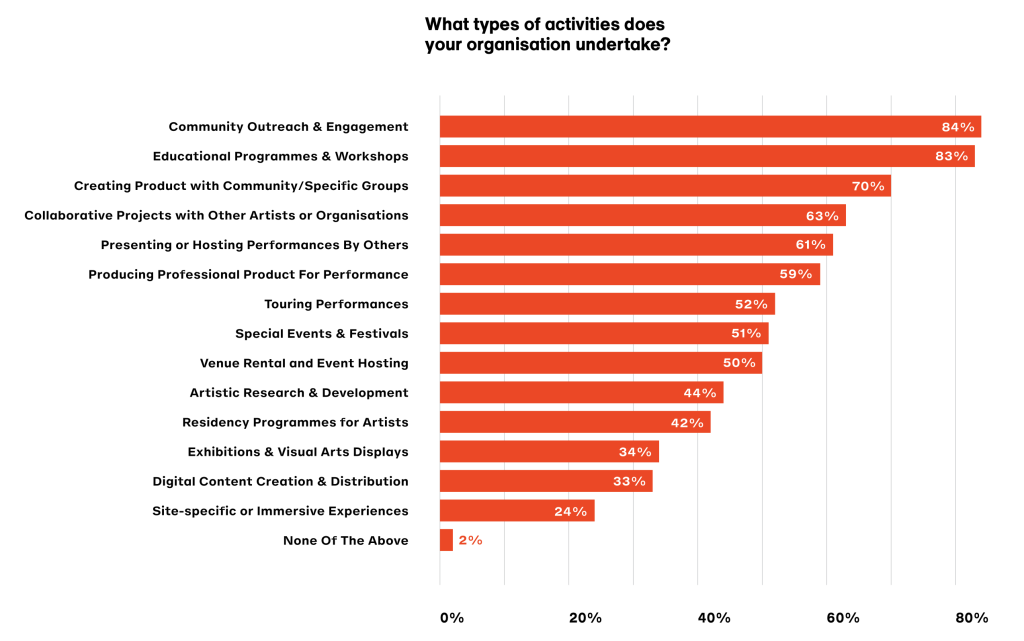Author: John Knell
Outcome Measurement
Since the Impact & Insight Toolkit’s inception in 2019, Counting What Counts (CWC) has been continually working with our project participants to co-create outcome measures that help them capture the full effect of their work. This has prompted CWC to develop new place-based measures, alongside an expanding set of community and social outcome measures. Explore these outcome measures, known as ‘dimensions’, here.
Therefore, it has long been clear to CWC that cultural organisations are increasingly blending cultural, social, and commercial value in their missions and business models.
National Theatre commissioned research, ‘Scene Change’
With this insight in mind, a new National Theatre funded research study, which CWC Director John Knell led, working with Amy Vaughan from Battersea Arts Centre, and Eliza Easton from Erskine Analysis, was published last month. Read the report, titled ‘Scene Change – optimising business model innovation in the performing arts’, on National Theatre’s website here.
The research explored the business models of performing arts organisations in England and provides a powerful analysis of the key business model types in the performing arts. The research calls for a range of sector-led and policy-led interventions to better support vital business model innovation across the sector.
One of the strongest empirical findings from the research was evidence underlining the extensive social pivot underway across the performing arts. The chart below features the self-reported categories of activities that the performing arts organisations who responded to our survey are currently undertaking (n =110). This data gives us a powerful insight into the activities that the majority of performing arts organisations are now engaging in.
 Responses to the question ‘What types of activities does your organisation undertake?’, when surveyed as part of the National Theatre research.
Responses to the question ‘What types of activities does your organisation undertake?’, when surveyed as part of the National Theatre research.
Over 80% of respondents are undertaking community outreach and engagement, organising and delivering educational programmes and workshops. A large proportion of organisations are undertaking collaborative projects (63% of respondents) and co-production activities with communities and specific groups (70% of respondents).
The Social Pivot
The sector’s desire for relevance, connection and civic contribution appears to be encouraging high levels of responsiveness to beneficiaries, and a very important social pivot across the performing arts. CWC has witnessed how this growing activity focus is being reflected in the outcome dimension choices being made by Toolkit participants.
Between April 2023 and February 2025, the two most frequently selected social outcome measures from the Dimensions Framework were:
- Inclusion [1] (used in 530 evaluations)
- Mental Wellbeing [2] (used in 430 evaluations)
Together, these two dimensions received nearly 50,000 public responses.
The next most selected outcomes were:
- Access [3] (used in 295 evaluations)
- Confidence [4] (used in 267 evaluations)
We will watch with interest how these activity and evaluation trends develop over the next two years of the Toolkit. If you are a participant in the Toolkit project and you have not yet explored all the social and community outcome measures in our Dimensions Framework, we urge you to do so. We would also encourage you to experiment with using some of these outcome measures in evaluations of any of your relevant work and projects. This is the best way of ensuring that you are capturing the full effect of your community and social mission-focussed activities – your social pivot.
Featured image credit: Maick Maciel on Unsplash
[1] ‘Inclusion’ dimension statement – It made me feel welcome and included
[2] ‘Mental wellbeing’ dimension statement – It had a positive impact on my mental wellbeing
[3] ‘Access’ dimension statement – It gave me the opportunity to access activities I would otherwise not have access to
[4] ‘Confidence’ dimension statement – It made me feel more confident about doing new things